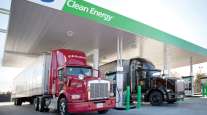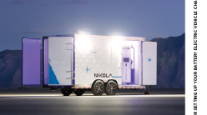Senior Reporter
West Coast Utilities Offer Plan for Charging Stations Along Interstate 5

[Stay on top of transportation news: Get TTNews in your inbox.]
Several West Coast electric utilities proposed a phased-in approach to electrifying Interstate 5 in an effort to reduce commercial vehicle emissions along the major freight corridor.
The proposal, released in June, recommends adding electric vehicle charging stations for freight haulers and delivery trucks at 50-mile intervals along the interstate and adjoining highways. I-5 travels 1,381 miles between Canada and Mexico.
The first phase would involve installing 27 charging sites along I-5 at 50-mile intervals for medium-duty electric vehicles — such as delivery vans, by 2025 — according to the proposal. Later, 14 of the 27 charging sites would be expanded to also accommodate charging for electric big rigs by 2030, when it is estimated that 8% of all trucks on the road in California could be electric.
West Coast Clean Transit Corridor Fact Sheet by Transport Topics on Scribd
The proposal emerged from the West Coast Clean Transit Corridor Initiative, a collaborative study commissioned by nine electric utilities and two agencies representing more than two dozen municipal utilities.
“The results of this study provide a road map for electric utilities in Washington, Oregon and California to help electrify transportation in a coordinated fashion,” Katie Sloan, director of eMobility and Building Electrification for Southern California Edison, said in a release. SCE is one of the study’s sponsors.
Of the 27 proposed sites, 16 are in California, five are in Oregon and six are in Washington. An additional 41 sites on other highways that connect to I-5 are being proposed for electrification. Those highways include interstates 8, 10, 80, 210 and 710 and state routes 60 and 99 in California; Interstate 84 in Oregon and Interstate 90 in Washington.
Other key findings in the report are:
- Most utilities in California, Oregon and Washington have enough capacity in urban areas along I-5 to support interconnections with the medium-duty charging sites. Rural areas are more of a challenge and none of the rural areas currently have capacity to serve heavy-duty site development.
- Utilities should serve as trusted infrastructure providers that can be leveraged to collaborate across a broad range of industry stakeholders, educate customers, help standardize systems of charging equipment for trucks and ensure safe deployment of charging sites.

COVID-19 has placed significant strain on many freight networks. So how are third-party logistics providers adapting to meet these challenges? Host Seth Clevenger chats with two 3PL executives who have had firsthand experience contending with this crisis. Hear a snippet, above, and get the full program by going to RoadSigns.TTNews.com.
Other sponsors of the study are the Los Angeles Department of Water & Power, Northern California Power Agency, Pacific Gas and Electric Company, Pacific Power, Portland General Electric, Puget Sound Energy, Sacramento Municipal Utility District, San Diego Gas & Electric, Seattle City Light and Southern California Public Power Authority.
Meanwhile, the North American Council for Freight Efficiency has started a three-year project to gain a better understanding of how commercial battery-electric vehicles will best fit into the regional haul market.
About 800,000 regional-haul trucks operate in the U.S., according to the group, which is partnering on the study with the Rocky Mountain Institute.
“Our perspective is that depot charging is going to be first, so, fleets owning the charging infrastructure,” NACFE Executive Director Mike Roeth told Transport Topics.

Roeth
“The more I get into this, the less homogeneous this all is,” Roeth added. “The less likely we are going to have a master plan because so much of this is unique,” he said. “I think it will be up to the states to do a lot of the work.”
He mentioned New York, New Jersey and North Carolina. “A lot of this electric vehicle thinking is around as much economic development, as it is ‘green.’ Utilities have to be looking at this as a huge opportunity for trucks to burn electricity instead of fuel,” he said.
Want more news? Listen to today's daily briefing:
Subscribe: Apple Podcasts | Spotify | Amazon Alexa | Google Assistant | More



